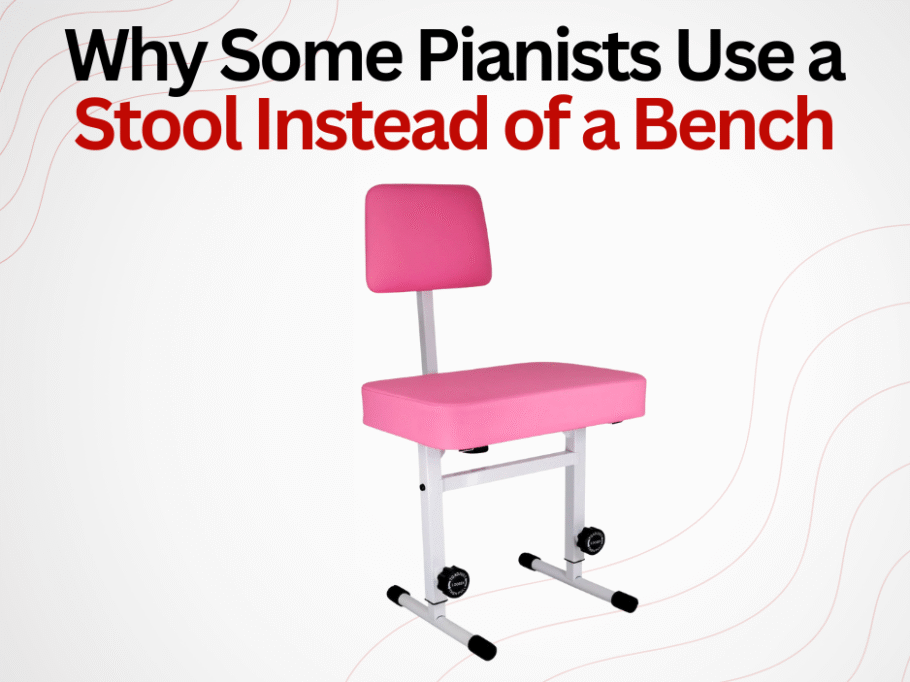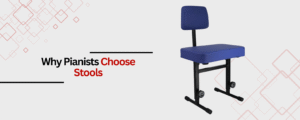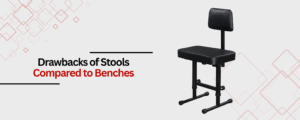The choice of seating at the piano is often influenced by a pianist’s personal preferences, playing style, and the space in which they perform. While the traditional piano bench is commonly seen in concert halls and home studios, many pianists opt for a stool instead. This decision is shaped by factors such as portability, space constraints, and the adaptability of stools to various music environments. The reasons behind this choice, as well as the advantages and drawbacks, are explored below.
To know more, Read: What’s Inside a Storage Piano Bench? A Look at Its Uses
Design Differences: Bench vs. Stool
Construction and Functionality:
Piano benches are typically longer, heavier, and more stable, designed to accommodate duets and provide a solid base for intense playing sessions. Models like the 5 Core PNB B-Rest Piano Benches offer thick padding, a wide seat, and even backrest options, ensuring comfort and ergonomic support during extended practice. Other benches, such as those from Donner and Roland, also feature adjustable heights and backrests, catering to players who prioritize posture and comfort.
In contrast, piano stools are more compact and lighter. They often feature a round or small rectangular seat and may lack the same level of padding or stability as benches. Some stools are height-adjustable by rotating the seat, making them adaptable for different users and playing situations. Their smaller footprint makes them suitable for tight spaces or for musicians who frequently move their setup.
Aesthetic and Practical Considerations:
Benches are designed to match the piano’s finish and add a touch of elegance to the music space. Stools, however, offer a wider variety of styles, from classic to modern, and can be chosen to complement a room’s décor or the pianist’s personality. While benches are often seen in formal settings, stools are favored in casual, educational, or studio environments due to their versatility.
Why Pianists Choose Stools
Portability and Space Efficiency:
Stools are preferred by pianists who value portability and need to save space. Their lightweight construction allows for easy movement and storage, which is particularly useful in small apartments, studios, or classrooms. For musicians who travel or perform in multiple locations, a stool can be a practical alternative to a bulkier bench.
Height Adjustability and Customization:
Many stools feature simple height adjustment mechanisms, such as a rotating seat, which allows for quick changes to accommodate different players or instruments. This flexibility is especially beneficial for children, students, or multi-instrumentalists who need to switch between playing styles.
Encouraging Good Posture:
Some pianists believe that using a stool without a backrest encourages better posture, as it requires the player to engage their core muscles and sit upright. While benches with backrests—like the 5 Core PNB B-Rest or select models from Donner and Roland—offer additional lumbar support for long sessions, stools provide a minimalist seating option that can help prevent slouching.
Upgrade your practice and performance setup—choose a piano bench that delivers ergonomic comfort and reliable support.
Find the ideal piano bench for your space and playing style—explore adjustable, cushioned options built for lasting use.
Drawbacks of Stools Compared to Benches
Reduced Comfort and Stability:
Stools often lack the thick padding and broad base of benches, making them less comfortable for prolonged playing. Stability may also be compromised, particularly during energetic performances or for pianists who move frequently across the keyboard. The absence of a backrest can lead to fatigue over time, especially during long practice sessions.
Limited Storage and Functionality:
Unlike many benches, which feature built-in storage for sheet music and accessories, stools rarely offer such conveniences. This can be a disadvantage for pianists who need easy access to their materials during practice or performance.
Conclusion
As with any other form of furniture, the decision to pick a stool over a bench is granted to the user’s artistic standards, specific uses, and an individual’s unique piano-playing demands and setting. There is no doubt that benches are a timeless option, but the increasing demand for stools clearly illustrates how players are evolving their routines and workspaces.
With respect to this emerging market, brands like 5 Core, Roland, and Donner have intelligently positioned themselves by providing an assortment of diverse solutions tailored to differing users’ bench expectations. Whether leaning towards the conservative or those appreciative of modern minimalism, the discussion surrounding piano stools vs. benches serves the deeper discourse revolving around customizability and ease of use in contemporary music culture. It is apparent that in the future the sustainability and ergonomics of these products and seating in general will be a hot topic. As time goes by, the endless possibilities shine with daily surprises.




